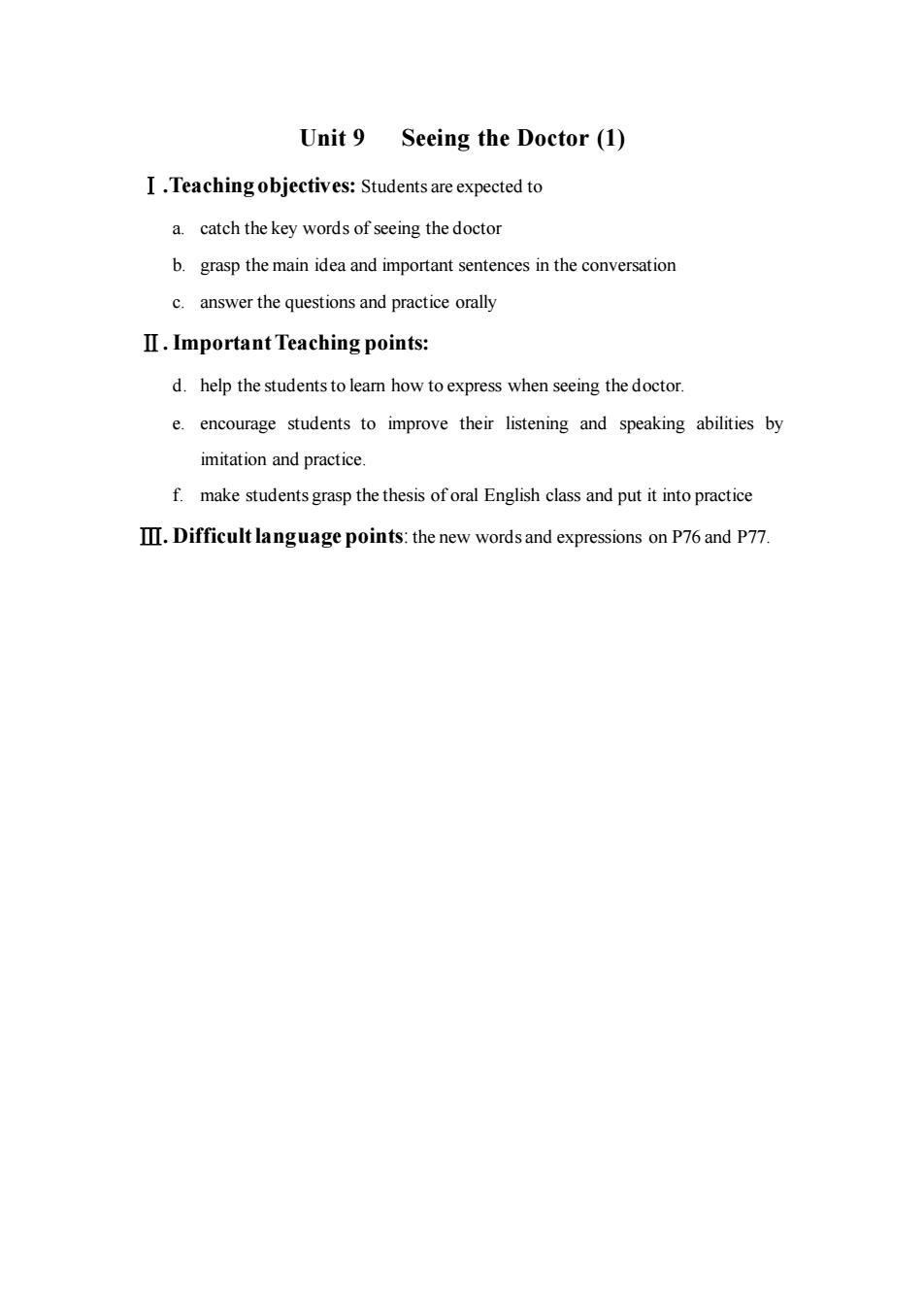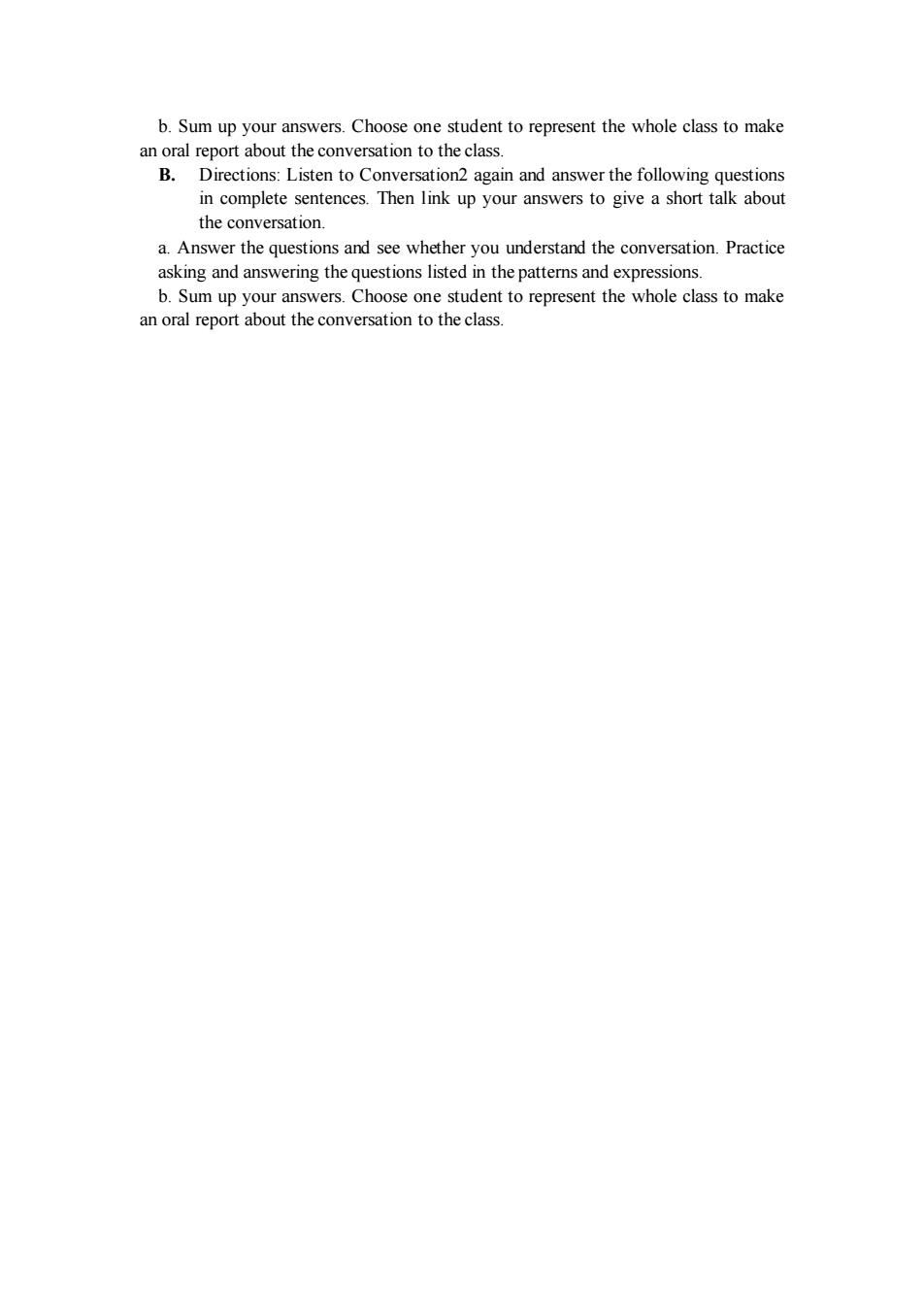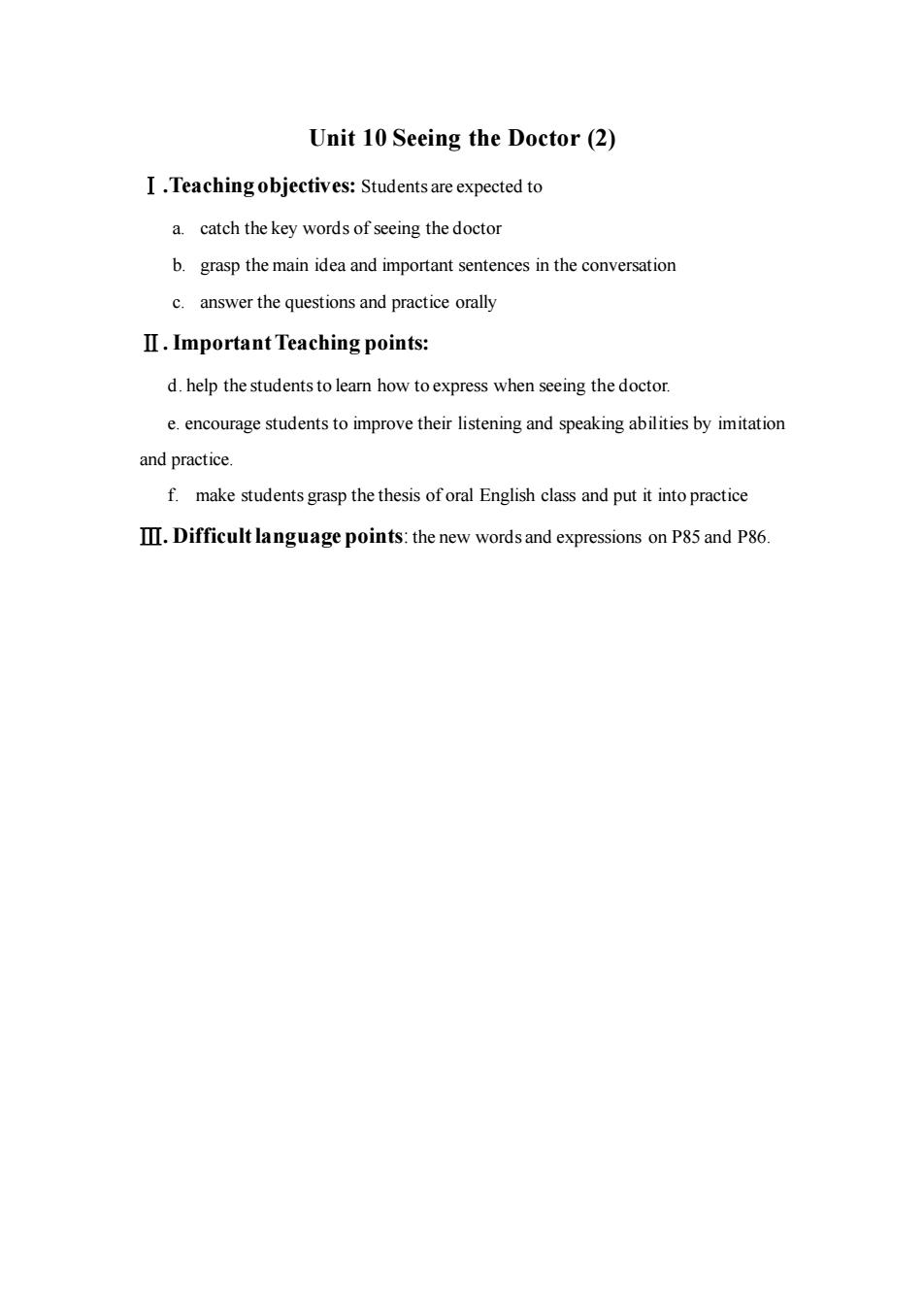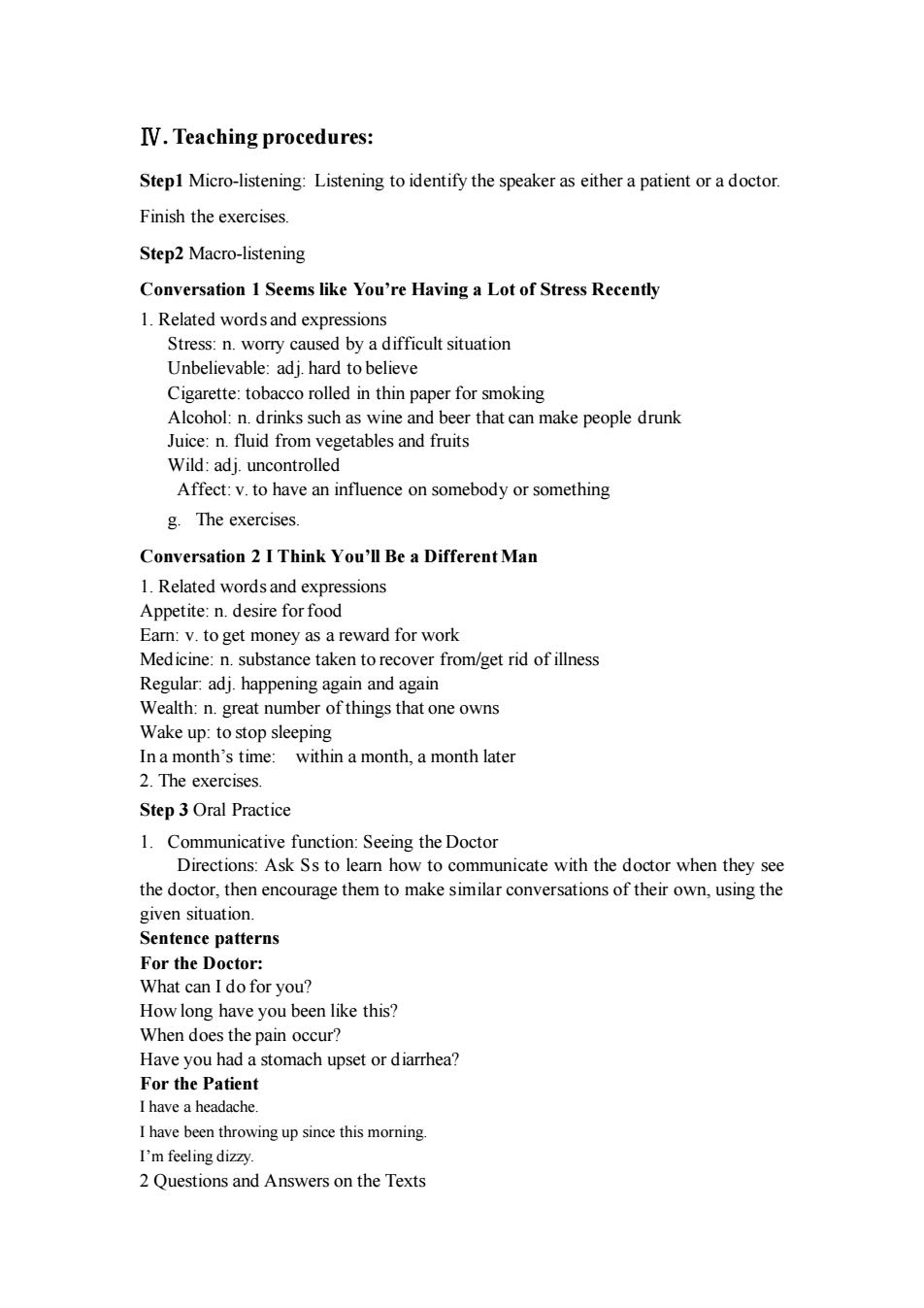
Unit 9 Seeing the Doctor (1) I.Teachingobjectives:Students are expected to a catch the key words of seeing the doctor b.grasp the main idea and important sentences in the conversation c.answer the questions and practice orally II.Important Teaching points: d.help the students to leam how to express when seeing the doctor e.encourage students to improve their listening and speaking abilities by imitation and practice f make students grasp the thesis of oral English class and put it into practice Difficult language points:the new words and expressions on P76 and P77
Unit 9 Seeing the Doctor (1) Ⅰ.Teaching objectives: Students are expected to a. catch the key words of seeing the doctor b. grasp the main idea and important sentences in the conversation c. answer the questions and practice orally Ⅱ. Important Teaching points: d. help the studentsto learn how to express when seeing the doctor. e. encourage students to improve their listening and speaking abilities by imitation and practice. f. make students grasp the thesis of oral English class and put it into practice Ⅲ. Difficult language points: the new words and expressions on P76 and P77

IV.Teaching procedures: StepI Micro-listening:Listening for sentence stress Finish the exercises. Step2 Macro-listening Conversation 1 At the Doctor's Office 1.Related words and expressions normally:adv.Usually,constantly通常地,经常地 headache:n.continuous pain in the head头痛 symptom:n.a sign of physical or mental illness tey:n.television电视 chart:n.a sheet of paper bottom:n.lowest part of anything optician:n.one who makes or sells eyeglasses配制眼镜的技师 d 病,受苦 2.The exercises. Conversation 2 What DoI Have to Do,Doctor? 2.Related words and expressions Confirm:v.to make sure that something is certain Pressure:n.force formed by pushing against something Cholesterol:n.a fatty substance found mostly in animal tissues.egg yolk.etc. Quit:v.to give up Weight:n.a measurement of how heavy a person of thing is Reduce:y.to make less Consultant:n.person who is a specialist in a certain subject and whose job is to give information and advice Diet:n,food and drink some people are limited to Program:n.plan,list of actions to be followed to achieve a certain purpose Heart attack:sudden break-out of heart disease Build up:to increase gradually,step by step 3.The exercises. Step 3 Oral Practice 1 Making Appropriate Responses Directions:Ask Ss to ask and answer the questions in pairs 2.Questions and Answers on the Texts Directions:Listen to Conversationl again and answer the following questions in complete sentences.Then link up your answers to make a short summary of Conversation 1. a.Answer the questions and see whether you understand the conversation.Practice asking and answering the questions listed in the patters and expressions
Ⅳ. Teaching procedures: Step1 Micro-listening: Listening for sentence stress. Finish the exercises. Step2 Macro-listening Conversation 1 At the Doctor’s Office 1.Related words and expressions normally: adv. Usually, constantly 通常地,经常地 headache: n. continuous pain in the head 头痛 symptom: n. a sign of physical or mental illness 症状 telly: n. television 电视 chart: n. a sheet of paper 表 bottom: n. lowest part of anything optician: n. one who makes or sells eyeglasses 配制眼镜的技师 appointment: n. arrangement to meet people at a particular time 约见 suffer from: to feel pain in your body or mind 患……病,受……苦 2. The exercises. Conversation 2 What Do I Have to Do, Doctor? 2. Related words and expressions Confirm: v. to make sure that something is certain Pressure: n. force formed by pushing against something Cholesterol: n. a fatty substance found mostly in animal tissues, egg yolk, etc. Quit: v. to give up Weight: n. a measurement of how heavy a person of thing is Reduce: v. to make less Consultant: n. person who is a specialist in a certain subject and whose job is to give information and advice Diet: n, food and drink some people are limited to Program: n. plan, list of actions to be followed to achieve a certain purpose Heart attack: sudden break-out of heart disease Build up: to increase gradually, step by step 3. The exercises. Step 3 Oral Practice 1 Making Appropriate Responses Directions: Ask Ss to ask and answer the questions in pairs. 2. Questions and Answers on the Texts A. Directions: Listen to Conversation1 again and answer the following questions in complete sentences. Then link up your answers to make a short summary of Conversation 1. a. Answer the questions and see whether you understand the conversation. Practice asking and answering the questions listed in the patterns and expressions

b.Sum up your answers.Choose one student to represent the whole class to make clas Directions:Listen to Conversation2 again and answer the following questions in complete sentences.Then link up your answers to give a short talk about the conversation. a.Answer the questions and see whether you understand the conversation.Practice an oral report about the conversation to the class
b. Sum up your answers. Choose one student to represent the whole class to make an oral report about the conversation to the class. B. Directions: Listen to Conversation2 again and answer the following questions in complete sentences. Then link up your answers to give a short talk about the conversation. a. Answer the questions and see whether you understand the conversation. Practice asking and answering the questions listed in the patterns and expressions. b. Sum up your answers. Choose one student to represent the whole class to make an oral report about the conversation to the class

Unit 10 Seeing the Doctor (2) I.Teaching objectives:Studentsare expected to a catch the key words of seeing the doctor b.grasp the main idea and important sentences in the conversation c.answer the questions and practice orally II.Important Teaching points: d.help the students to learn how to express when seeing the doctor. e.encourage students to improve their listening and speaking abilities by imitation and practice. f.make students grasp the thesis of oral English class and put it into practice Difficult language points:the new words and expressions on P85 and P86
Unit 10 Seeing the Doctor (2) Ⅰ.Teaching objectives: Students are expected to a. catch the key words of seeing the doctor b. grasp the main idea and important sentences in the conversation c. answer the questions and practice orally Ⅱ. Important Teaching points: d. help the studentsto learn how to express when seeing the doctor. e. encourage students to improve their listening and speaking abilities by imitation and practice. f. make students grasp the thesis of oral English class and put it into practice Ⅲ. Difficult language points: the new words and expressions on P85 and P86

IV.Teaching procedures: Stepl Micro-listening:Listening to identify the speaker as either a patient or a doctor. Finish the exercises Step2 Macro-listening Conversation 1 Seems like You're Having a Lot of Stress Recently 1.Related words and expressions Stress:n.worry caused by a difficult situation Unbelievable:adj.hard to believe Cigarette:tobacco rolled in thin paper for smoking Alcohol:n.drinks such as vine and eer that can make people drunk fui from vegetablesand Wild:adj.uncontrolled Affect:v.to have an influence on somebody or something g.The exercises Conversation 2 I Think You'll Be a Different Man 1.Related words and expressions Appetite:n.desire for food Earn:v.to get money as a reward for work Medicine:n.substance taken to recover from/get rid of illness Wealth:n.great number of things that one owns Wake up:to stop sleeping Ina month's time:within a month,a month later 2.The exercises. Step 3 Oral Practice 1.Communicative function:Seeing the Doctor Directions:Ask Ss to leamn how to communicate with the doctor when they see the doctor,then encourage them to make similar conversations of their own,using the For the Doctor: What can I do for you? How long have you been like this? When does the pain occur? Have you had a stomach upset or diarrhea? I have been throwing up since this morning. I'm feeling dizzy. 2Questions and Answers on the Texts
Ⅳ. Teaching procedures: Step1 Micro-listening: Listening to identify the speaker as either a patient or a doctor. Finish the exercises. Step2 Macro-listening Conversation 1 Seems like You’re Having a Lot of Stress Recently 1. Related words and expressions Stress: n. worry caused by a difficult situation Unbelievable: adj. hard to believe Cigarette: tobacco rolled in thin paper for smoking Alcohol: n. drinks such as wine and beer that can make people drunk Juice: n. fluid from vegetables and fruits Wild: adj. uncontrolled Affect: v. to have an influence on somebody or something g. The exercises. Conversation 2 I Think You’ll Be a Different Man 1. Related words and expressions Appetite: n. desire for food Earn: v. to get money as a reward for work Medicine: n. substance taken to recover from/get rid of illness Regular: adj. happening again and again Wealth: n. great number of things that one owns Wake up: to stop sleeping In a month’s time: within a month, a month later 2. The exercises. Step 3 Oral Practice 1. Communicative function: Seeing the Doctor Directions: Ask Ss to learn how to communicate with the doctor when they see the doctor, then encourage them to make similar conversations of their own, using the given situation. Sentence patterns For the Doctor: What can I do for you? How long have you been like this? When does the pain occur? Have you had a stomach upset or diarrhea? For the Patient I have a headache. I have been throwing up since this morning. I’m feeling dizzy. 2 Questions and Answers on the Texts

A.Directions:Listen to Conversationl and Conversation 2 again and answer the following questions in complete sentences.Then link up your answers to give a shor talk about Conversation 1 and make a short summary of Conversation 2. a.Answer the questions and see whether you understand the conversation.Practice asking and answering the questions listed in the patterns and expressions. 2.Sum up (or link up)your answers.Choose one student to make a separate oral report about the two conversations to the class
A. Directions: Listen to Conversation1 and Conversation 2 again and answer the following questions in complete sentences. Then link up your answers to give a short talk about Conversation 1 and make a short summary of Conversation 2. a. Answer the questions and see whether you understand the conversation. Practice asking and answering the questions listed in the patterns and expressions. 2. Sum up (or link up) your answers. Choose one student to make a separate oral report about the two conversations to the class